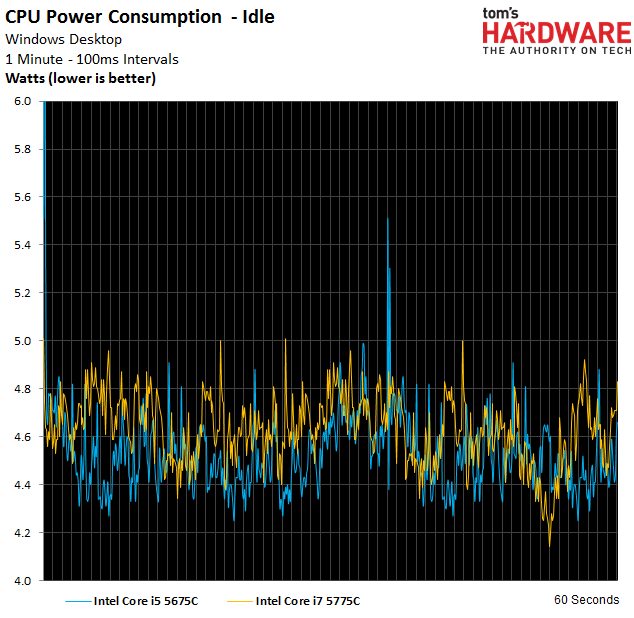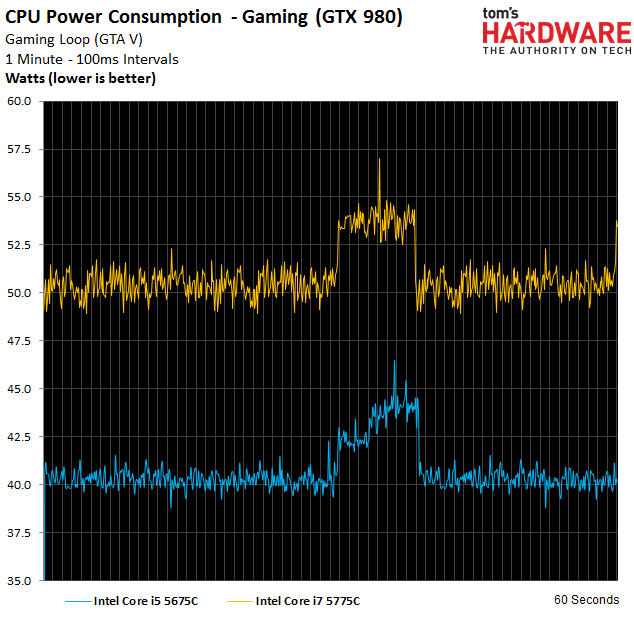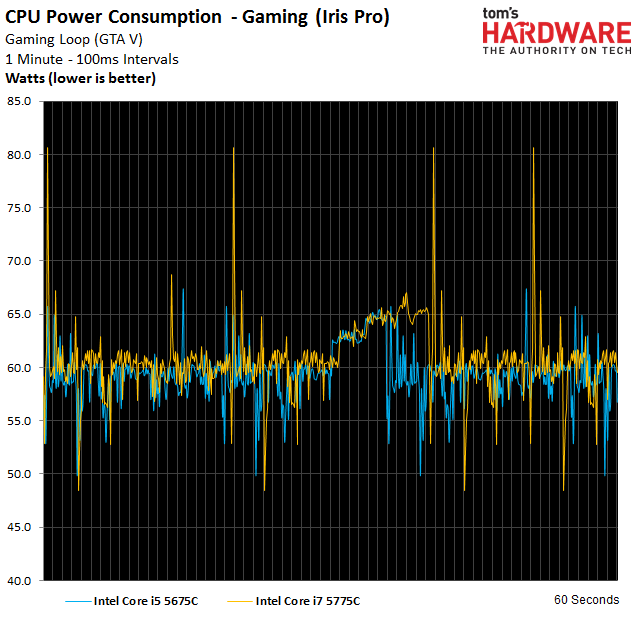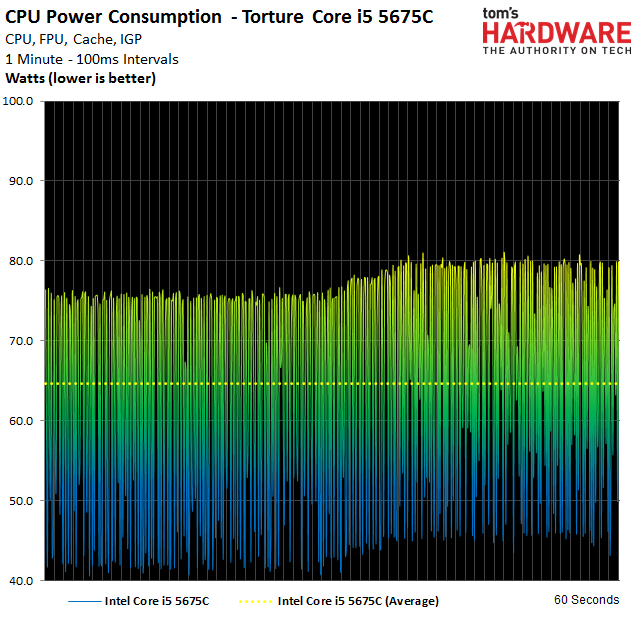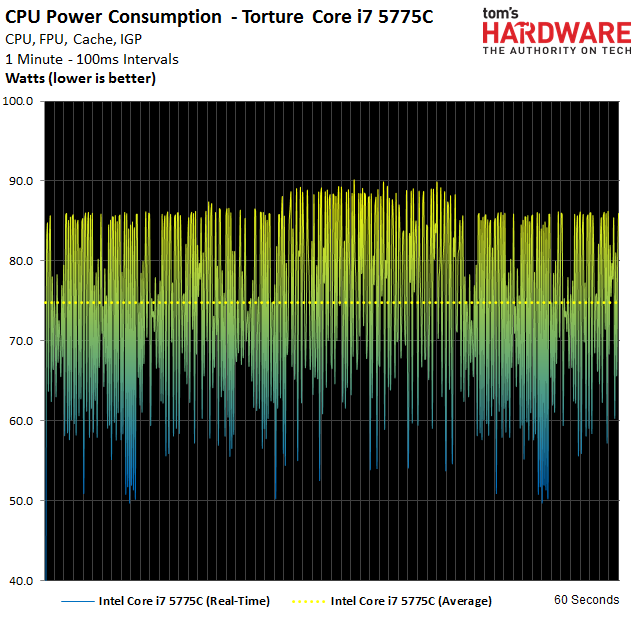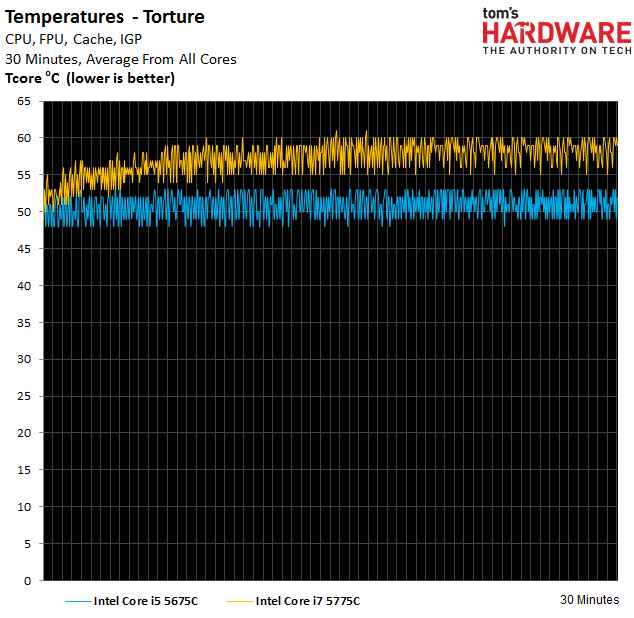Broadwell: Intel Core i7-5775C And i5-5675C Review
Power And Temperature In Detail
Idle Power Consumption
If our measurements and the sensors are to be believed, then the two CPUs’ power consumption at idle is well under 5W without integrated graphics. Running with integrated graphics enabled and without an external graphics card results in less than 6W. Desktop graphics that only consume 1W are unheard of. Whether you're talking about previous-gen Intel or current AMD solutions, every other implementation uses a lot more power.
Gaming Power Consumption
Let’s think back to our GTA V performance test. We’re rendering a power-hungry scene (driving a car at night) using the integrated recorder to create a load for our measurements. The average power consumption of Intel's Core i5-5675C comes in at a moderate 42W, whereas the Core i7-5775C consumes 52W. The peaks show that these numbers might go up if the CPU is maxed out. We’ll take a closer look at this soon with our stress test.
So what happens when the integrated graphics engine takes over rendering duties? This limits the processor's x86 cores, and its peaks are consequently not as pronounced as they were (starting toward the middle of our test run). The power consumption of the two CPUs becomes almost identical in this scenario, which makes sense, since the Iris Pro implementations are identical. The power consumption averages approximately 62W.
Maximum Power Consumption (Stress Test)
We’re putting the whole processor under maximum load to see how the picture changes. Both Broadwell-based models are plotted in separate graphs to make them easier to see. These charts show the telemetry’s frantic efforts to adjust the load nicely. This is similar to what we’re used to seeing from today’s graphics cards.
The more mainstream Core i5-5675C comes in at 65W, which is just shy of its 66W TDP. Intel's Core i7-5775C is more liberal, which is to say that it consumes 74W, or approximately 10W more than its smaller sibling. The reason for this is its higher clock rate, as well as Hyper-Threading technology keeping the available cores better-utilized. That latter feature yields a significant speed-up in tasks able to exploit threading (such as our stress test), though it does affect power consumption.
We’ll get to how all of these results stack up to Intel's previous-gen architectures and AMD's competition on the next page. Before that, though, we need to cover the by-product of power consumption: heat.
Temperatures at Full Load (During the Stress Test)
All parts of the processor (including the integrated graphics) need to be stressed to generate a significant amount of waste heat. The average temperature across all cores after 30 minutes is 52 degrees Celsius for the Core i5-5675C and 58 degrees Celsius for the Core i7-5775C. The package temperatures are a maximum of 40 and 43 degrees Celsius, respectively. We’re cooling the processors on our usual benchmark system with a Raijintek Triton 360 All-In-One open-loop compact liquid CPU cooler.
Get Tom's Hardware's best news and in-depth reviews, straight to your inbox.
It’s hard to compare these temperatures to those generated by discrete graphics cards, since the new architecture's power consumption is significantly lower. If the performance-to-power consumption ratio is taken into account, then Broadwell stays significantly cooler.
Current page: Power And Temperature In Detail
Prev Page How We Tested Next Page Power Consumption Overview-
RNOblivion Proof read your articles. This seems to be an increasing prevalent theme of Tom's over the last couple years.Reply -
greghome are these numbers real?.............Not only does it match lower mid range cards, but it completely destorys AMD's APUs........Reply
:shock: -
Nuckles_56 With the Sandra 2015 benchmark on the first page, you are testing the i7 7557c against the i7 4790k instead of the i7 5775cReply -
babernet_1 Sad how AMD is absolutely shoved into the dust bin. I hope their upcoming Zen next year will be worthwhile with its 14nm process and more Intel-like cores.Reply
-
wtfxxxgp This is exactly what I said to a buddy of mine about a month ago. Everyone is going on about how little Intel has done with CPUs over the past few years - presumably due to no real competition from AMD. Then people starting looking to Zen as being the real competitor for Intel and saying things like "Intel are in for a shock" - I had the view that Intel weren't resting on their laurels all this time - they've just been biding their time and doing amazing things in a hush hush manner. When Zen is released it will soon be completely obliterated by some of the tech that Intel would have been working on in the meantime - AMD has lagged too far behind for too long and love them or hate them, Intel is the benchmark when it comes to CPUs - period. They own this space, and these 2 chips have just rendered AMD APUs completely useless now. I'd be interested in this for a HTPC solution with some light gaming - League of Legends etc. This is impressive, however, like the article concluded, what a poor time for them to be released.Reply -
Grognak Wow. 93% better average framerate in GTA V than a 7850K with DDR3-2400 RAM... And that's just the i5. Incredible.Reply -
shrapnel_indie Since Broadwell is unlocked, would have been interesting to see how they overclocked. Yeah Skylake is breathing down the neck of Broadwell now thanks to the delays it suffered... but still would be fun to see.Reply
You’ve waited this long—why not hang tight for a few months for Skylake and start anew with 100-series chipsets, DDR4 and the return of unlocked 95W K-series CPUs?
Last I heard Skylake was supposed to support DDR3 and DDR4. Was that just a rumor that wasn't the truth or will it actually support DDR3 as well?
-
alpha27 heh iris coming close to a 750gtx 500 cuda core NVidia better watch out heyReply
hmm if intel whacked a few iris's on a gfx chip and did there thing they could possibly beat NVidia...and make even more money lol, hmm mutli 128mb ring buses and iris core's and hbm...delicious -
de5_Roy it's a good review. two big reviews back to back, nice job. :)Reply
i missed some things:
unlocked broadwells but no o.c. not even a little look into how these overclock and behave o.c.ed.
no comparison (gaming, power use, htpc etc.) with the desktop haswell i5 and i7 -R cpus' iris pro igpus. the amd comparisons were good though. i hope you guys test these against the haswell iris pro later.
in some of the charts, the core i7 5775 was written as i7 7557.
in the test setup page, system memory section, is it "transcend" instead of "transcent"?
edit:
one last thing: do these unlocked broadwell cpus really have 16x gen 3.0 lanes off the processor? i thought these were soc dies (with southbridge disabled) with 8x gen 3.0 lanes. -
SteelCity1981 not surprising given that it has an irs pro gpu in it, that's intel top of the line gpu. now obv even with that said it's in no competition with highend gpus from NVidia or amd as any apu's gpu would get destroyed, but what's good is the fact that it's helping to push gpus on apu's to become better and better and since intel has greatly stepped up their game in the apu's gpu department i'd expect amd to step up their game even further and push back. I also see that since there is such a big gain with broadwells gpu, that skylake won't see any real jump in that department. i'd imagine that the irs 6000 series is going to carry over onto skylake with little improvement over broadwells irs 6200.Reply
